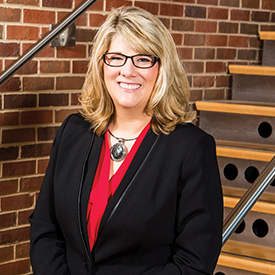 Christina Grabowski is the School of Medicine's new associate dean for admissions and enrollment management. MCAT scores, grade point averages, and research experiences are among the criteria medical school admissions committees traditionally consider when deciding which applicants to admit. Today, medical schools are also turning to data collection and analysis to help identify students who are likely to become, for example, leaders in clinical research or primary care. They then use that data to adapt their admissions policies and curricula.
Christina Grabowski is the School of Medicine's new associate dean for admissions and enrollment management. MCAT scores, grade point averages, and research experiences are among the criteria medical school admissions committees traditionally consider when deciding which applicants to admit. Today, medical schools are also turning to data collection and analysis to help identify students who are likely to become, for example, leaders in clinical research or primary care. They then use that data to adapt their admissions policies and curricula.
These are the kinds of issues Christina Grabowski, Ph.D., the School of Medicine’s new associate dean for admissions and enrollment management, thinks about every day. “The ability to take the admissions process to the next level at a medical school with a national reputation and the opportunity to work with all the talented people here at UAB is exciting to me,” she says.
Grabowski started in undergraduate admissions at Oakland University in Michigan, where she was assistant director of admissions and enrollment management. She later served as the director of graduate marketing and recruitment there. In 2009, Grabowski became assistant dean of admissions at Oakland University William Beaumont (OUWB) School of Medicine, a position that prepared her for her role at UAB.
Grabowski gained a national reputation for her expertise in holistic review admissions while at OUWB School of Medicine. She was involved with the Association of American Medical Colleges (AAMC) Advancing Holistic Review Initiative and facilitated numerous holistic review workshops for the AAMC. Holistic review is a method in which admissions committees consider an applicant’s resiliency, listening skills, personal life experiences, and a host of other attributes in addition to more traditional measures like MCAT scores and grade point averages.
“Sometimes people think there is only one set of admissions criteria and everyone has to meet a cookie-cutter profile,” says Grabowski. “That’s not what holistic review is. It’s the individual consideration of an applicant and how they can contribute to the learning environment as well as the workforce. We want a diverse student body and workforce, because having one type of doctor doesn’t meet all health care needs.”
Grabowski says the latest trend in medical school admissions involves gathering data that measures existing students’ performances through graduation and beyond. That data might include information on how well medical students perform on structured clinical examinations, patient satisfaction scores graduates earn on the job, and even which graduates become chief residents or department chairs. That information enables medical schools to make informed, evidence-based decisions about their admissions criteria, curriculum, and other factors in order to produce the type of graduates they want, Grabowski says.
Craig Hoesley, M.D., the School of Medicine’s senior associate dean for medical education, says Grabowski’s knowledge and expertise, paired with the school’s desire to be an innovator in medical school admissions and enrollment management, makes her ideal for the job. “She will help UAB to become a leader in this area,” he says.
Hoesley says the School of Medicine expanded the scope of the role from assistant dean of admissions to associate dean for admissions and enrollment management. In this role, Grabowski will develop new strategies to collect data and analyze applicants and matriculated students to meet specific goals like increasing diversity.
“I am also charged with creating a more transparent, friendly environment for applicants,” Grabowski explains. “We’ll use social media to keep students abreast of where we are in the process. We’ll use interpersonal communications, too. That might involve being more available for calls, more responsive to emails, more proactive in sending out messages, and really opening up more lines of communication with prospective students.”
To start, Grabowski is meeting with alumni, faculty, and students, and holding open forums with admissions committee members to assess strengths in the admissions process and discuss areas for improvement. “I’m delighted to have the opportunity to work with members of our community to grow our admissions program and make it more user-friendly and transparent for everyone involved,” she says.
By Gail Allyn Short